Synthesis of a Novel Hydrazone of Thieno[2,3-d]pyrimidine Clubbed with Ninhydrin: X-ray Crystal Structure and Computational Investigations
Abstract
1. Introduction
2. Materials and Methods
2.1. General
2.2. Synthesis of N′-(1,3-dioxo-1,3-dihydro-2H-inden-2-ylidene)-2-(4-oxo-5,6,7,8-tetrahydrobenzo[4,5]thieno[2,3-d]pyrimidin-3(4H)-yl)Acetohydrazide 4
2.3. X-ray Structure Determination
2.4. Hirshfeld Surface Analysis
3. Computational Methods
4. Results and Discussion
4.1. Synthesis and NMR Characterizations of 4
4.2. Crystal Structure Description
4.3. Hirshfeld Analysis
4.4. DFT Studies
4.5. Natural Orbital Analysis
5. Conclusions
Supplementary Materials
Author Contributions
Funding
Data Availability Statement
Acknowledgments
Conflicts of Interest
References
- Ali, E.M.; Abdel-Maksoud, M.S.; Oh, C.H. Thieno [2,3-d] pyrimidine as a promising scaffold in medicinal chemistry: Recent advances. Bioorg. Med. Chem. 2019, 27, 1159–1194. [Google Scholar] [CrossRef] [PubMed]
- Bánhegyi, P.; Kéri, G.; Örfi, L.; Szekélyhidi, Z.; Wáczek, F.; Kft, V.C.K. Tricyclic Benzo [4, 5]thieno-[2, 3-d] Pyrimidine-4-yl-amin Derivatives, Their Salts, Process for Producing the Compounds and Their Pharmaceutical Use. U.S. Patent 8,802,849, 12 August 2014. [Google Scholar]
- Rheault, T.R.; Caferro, T.R.; Dickerson, S.H.; Donaldson, K.H.; Gaul, M.D.; Goetz, A.S.; Mullin, R.J.; McDonald, O.B.; Petrov, K.G.; Rusnak, D.W.; et al. Thienopyrimidine-based dual EGFR/ErbB-2 inhibitors. Bioorg. Med. Chem. Lett. 2009, 19, 817–820. [Google Scholar] [CrossRef] [PubMed]
- Wu, C.-H.; Coumar, M.S.; Chu, C.-Y.; Lin, W.-H.; Chen, Y.-R.; Chen, C.-T.; Shiao, H.-Y.; Rafi, S.; Wang, S.-Y.; Hsu, H.; et al. Design and Synthesis of Tetrahydropyridothieno [2,3-d]pyrimidine Scaffold Based Epidermal Growth Factor Receptor (EGFR) Kinase Inhibitors: The Role of Side Chain Chirality and Michael Acceptor Group for Maximal Potency. J. Med. Chem. 2010, 53, 7316–7326. [Google Scholar] [CrossRef] [PubMed]
- Dai, Y.; Guo, Y.; Frey, R.R.; Ji, Z.; Curtin, M.L.; Ahmed, A.A.; Albert, D.H.; Arnold, L.; Arries, S.S.; Barlozzari, T.; et al. Thienopyrimidine Ureas as Novel and Potent Multitargeted Receptor Tyrosine Kinase Inhibitors. J. Med. Chem. 2005, 48, 6066–6083. [Google Scholar] [CrossRef] [PubMed]
- Ameen, M.A.; Ahmed, E.K.; Mahmoud, H.I.; Ramadan, M. Synthesis and screening of phosphodiesterase 5 inhibitory activity of fused and isolated triazoles based on thieno [2, 3-d] pyrimidines. J. Heterocycl. Chem. 2019, 56, 1831–1838. [Google Scholar] [CrossRef]
- Rizk, O.H.; Shaaban, O.G.; El-Ashmawy, I.M. Design, synthesis and biological evaluation of some novel thienopyrimidines and fused thienopyrimidines as anti-inflammatory agents. Eur. J. Med. Chem. 2012, 55, 85–93. [Google Scholar] [CrossRef] [PubMed]
- Ameena, M.A.; Ahmeda, E.K.; Abdellatifa, F.F. A Novel Synthetic Routes to New 3-Substituted4-oxo-3,4,5,6,7,8-hexahydropyrido[4],[4],[5] thieno[2],[3]pyrimidine-7-carboxylic Acid Ethyl Ester Derivatives. Phosphorus Sulfur Silicon Relat. Elem. 2005, 180, 95–107. [Google Scholar] [CrossRef]
- Alagarsamy, V.; Meena, S.; Ramsesh, K.V.; Solomon, V.R.; Thirumurugan, D.K.; Dhanabala, K.; Murugana, M. Synthesis, analgesic, anti-inflammatory, ulcerogenic index and antibacterial activities of novel 2methylthio-3-substituted-5,6,7,8 tetrahydro benzo(b) thieno [2,3-d]pyrimidin-4(3H)-ones. Eur. J. Med. Chem. 2006, 41, 1293–1300. [Google Scholar] [CrossRef]
- Al-Taisan, K.M.; Al-Hazimi, H.M.; Al-Shihry, S.S. Synthesis, characterization and biological studies of some novel thieno [2,3-d]pyrimidines. Molecules 2010, 15, 3932–3957. [Google Scholar] [CrossRef]
- Ghoraba, M.M.; Osmanb, A.N.; Noamanc, E.; Heibaa, H.I.; Zahera, N.H. The synthesis of some new sulfur heterocyclic compounds as potential radioprotective and anticancer agents. Phosphorus Sulfur Silicon Relat. Elem. 2006, 181, 1935–1950. [Google Scholar] [CrossRef]
- Azaba, M.E. Utility of the enamino nitrile moiety in the synthesis of some biologically active thienopyrimidine derivatives. Phosphorus Sulfur Silicon Relat. Elem. 2006, 183, 1766–1782. [Google Scholar] [CrossRef]
- Abdelrahman, S.; El-Gohary, N.S.; Elbendary, E.; El-Ashry, S.M.; Shaaban, M.I. Synthesis, antimicrobial, antiquorum-sensing, antitumor and cytotoxic activities of new series of cyclopenta(hepta)[b]thiophene and fused cyclohepta[b]thiophene analogs. Eur. J. Med. Chem. 2017, 140, 200–211. [Google Scholar] [CrossRef]
- Lagardère, P.; Fersing, C.; Masurier, N.; Lisowski, V. Thienopyrimidine: A Promising Scaffold to Access Anti-Infective Agents. Pharmaceuticals 2022, 15, 35. [Google Scholar] [CrossRef]
- Chaykovsky, M.; Lin, M.; Rosowsky, A.; Modest, E.J. 2,4-Diaminothieno [2,3-d]pyrimidines as antifolates and antimalarials. 2. Synthesis of 2,4-diaminopyrido [4’,3’:4,5]thieno [2,3-d]pyrimidines and 2,4-diamino-8H-thiopyrano [4’,3’:4,5]thieno [2,3-d]pyrimidines. J. Med. Chem. 1973, 16, 188–191. [Google Scholar] [CrossRef]
- Gad, E.M.; Nafie, M.S.; Eltamany, E.H.; Hammad, M.S.; Barakat, A.; Boraei, A.T. Discovery of new apoptosis-inducing agents for breast cancer based on ethyl 2-amino-4,5,6,7-tetrahydrobenzo[b] thiophene-3-carboxylate: Synthesis, in vitro, and in vivo activity evaluation. Molecules 2020, 25, 2523. [Google Scholar] [CrossRef]
- Elmenier, F.M.; Lasheen, D.S.; Abouzid, K.A. Design, synthesis, and biological evaluation of new thieno [2, 3-d] pyrimidine derivatives as targeted therapy for PI3K with molecular modelling study. J. Enzym. Inhib. Med. Chem. 2022, 37, 315–332. [Google Scholar] [CrossRef]
- Laporte, G.M.; Ramotowski, R.S. The effects of latent print processing on questioned documents produced by office machine systems utilizing inkjet technology and toner. J. Forensic Sci. 2003, 48, 658–663. [Google Scholar] [CrossRef]
- Schwarz, L.; Frerichs, I. Advanced solvent-free application of ninhydrin for detection of latent fingerprints on thermal paper and other surfaces. J. Forensic Sci. 2002, 47, 1274–1277. [Google Scholar] [CrossRef]
- Petraco, N.D.; Proni, G.; Jackiw, J.J.; Sapse, A.M. Amino acid alanine reactivity with the fingerprint reagent ninhydrin. A detailed ab initio computational study. J. Forensic Sci. 2006, 51, 1267–1275. [Google Scholar] [CrossRef]
- Alvarez, M.R.; Laíño, R.B.; Díaz-García, M.E. Insights into the ninhydrin chemiluminescent reaction and its potential for micromolar determination of human serum albumin. J. Lumin. 2006, 118, 193–198. [Google Scholar] [CrossRef]
- Das, S.; Maity, S.; Ghosh, P.; Paul, B.K.; Dutta, A. Base Promoted Tandem Cyclization of o-Phenylenediamine with Ninhydrin-phenol Adducts: An Unprecedented Route to Phenol Appended Isoindolo [2, 1-a] quinoxaline Fluorophore. ChemistrySelect 2019, 4, 2656–2662. [Google Scholar] [CrossRef]
- Patil, S.A.; Patil, R.; Patil, S.A. Recent developments in biological activities of indanones. Eur. J. Med. Chem. 2017, 138, 182–198. [Google Scholar] [CrossRef] [PubMed]
- Verma, G.; Marella, A.; Shaquiquzzaman, M.; Akhtar, M.; Ali, M.R.; Alam, M.M. A review exploring biological activities of hydrazones. J. Pharm. Bioallied. Sci. 2014, 6, 69–80. [Google Scholar] [PubMed]
- Shakdofa, M.; Shtaiwi, M.; Morsy, N.M.; Abdel-Rassel, T.M.A. Metal complexes of hydrazones and their biological, analytical and catalytic applications: A review. Main Group Chem. 2014, 13, 187–218. [Google Scholar] [CrossRef]
- Sharma, A.; Mehta, T.; Shah, M.K. Synthesis and spectral studies of transition metal complexes supported by NO-bidentate Schiff-Base ligand. Der Chem. Sin. 2013, 4, 141–146. [Google Scholar]
- Boraei, A.T.A.; Soliman, S.M.; Haukka, M.; Salama, E.E.; Sopaih, M.; Barakat, A.; Sarhan, A.M. Straightforward green synthesis of indeno-furan carboxylates from ninhydrin and β-ketoesters: X-Ray crystal structure, Hirshfeld and DFT investigations. J. Mol. Str. 2022, 1255, 132433. [Google Scholar] [CrossRef]
- Rikagu Oxford Diffraction. CrysAlisPro; Rikagu Oxford Diffraction Inc.: Yarnton, UK, 2022. [Google Scholar]
- Sheldrick, G.M. SADABS—Bruker Nonius Scaling and Absorption Correction; Bruker AXS, Inc.: Madison, WI, USA, 2012. [Google Scholar]
- Sheldrick, G.M. SHELXT-Integrated Space-Group and Crystal-Structure Determination. Acta Crystallogr. Sect. A Found. Adv. 2015, 71, 3–8. [Google Scholar] [CrossRef]
- Hübschle, C.B.; Sheldrick, G.M.; Dittrich, B. ShelXle: A Qt graphical user interface for SHELXL. J. Appl. Crystallogr. 2011, 44, 1281–1284. [Google Scholar] [CrossRef]
- Turner, M.J.; McKinnon, J.J.; Wolff, S.K.; Grimwood, D.J.; Spackman, P.R.; Jayatilaka, D.; Spackman, M.A. Crystal Explorer17; University of Western Australia: Perth, Australia, 2017; Available online: http://hirshfeldsurface.net (accessed on 20 July 2017).
- Frisch, M.J.; Trucks, G.W.; Schlegel, H.B.; Scuseria, G.E.; Robb, M.A.; Cheeseman, J.R.; Scalmani, G.; Barone, V.; Mennucci, B.; Petersson, G.A.; et al. GAUSSIAN 09; Revision A02; Gaussian Inc.: Wallingford, CT, USA, 2009. [Google Scholar]
- Dennington, R., II; Keith, T.; Millam, J. (Eds.) GaussView; Version 4.1; Semichem Inc.: Shawnee Mission, KS, USA, 2007. [Google Scholar]
- Reed, A.E.; Curtiss, L.A.; Weinhold, F. Intermolecular interactions from a natural bond orbital, donor-acceptor viewpoint. Chem. Rev. 1988, 88, 899–926. [Google Scholar] [CrossRef]
- Becke, A.D. Density-Functional Thermochemistry. III. The Role of Exact Exchange. J. Chem. Phys. 1993, 98, 5648–5652. [Google Scholar] [CrossRef]
- Lee, C.; Yang, W.; Parr, R.G. Development of the Colle-Salvetti correlation-energy formula into a functional of the electron density. Phys. Rev. B 1988, 37, 785–789. [Google Scholar] [CrossRef]
- Stephens, P.J.; Devlin, F.J.; Chabalowski, C.F.; Frisch, M.J. Ab Initio Calculation of Vibrational Absorption and Circular Dichroism Spectra Using Density Functional Force Fields. J. Phys. Chem. 1994, 98, 11623–11627. [Google Scholar] [CrossRef]
- Foresman, J.B.; Frisch, Æ. Exploring Chemistry with Electronic Structure Methods, 2nd ed.; Gaussian: Pittsburgh, PA, USA, 1996. [Google Scholar]
- Chang, R. Chemistry, 7th ed.; McGraw-Hill: New York, NY, USA, 2001. [Google Scholar]
- Kosar, B.; Albayrak, C. Spectroscopic investigations and quantum chemical computational study of (E)-4-methoxy-2-[(p-tolylimino) methyl] phenol. Spectrochim. Acta 2011, 78, 160–167. [Google Scholar] [CrossRef]
- Koopmans, T.A. Ordering of wave functions and eigenenergies to the individual electrons of an atom. Physica 1933, 1, 104–113. [Google Scholar] [CrossRef]
- Parr, R.G.; Yang, W. Density-Functional Theory of Atoms and Molecules; Oxford University Press: New York, NY, USA, 1989. [Google Scholar]
- Parr, R.G.; Szentpaly, L.V.; Liu, S. Electrophilicity index. J. Am. Chem. Soc. 1999, 121, 1922–1924. [Google Scholar] [CrossRef]
- Singh, R.N.; Kumar, A.; Tiwari, R.K.; Rawat, P.; Gupta, V.P. A combined experimental and quantum chemical (DFT and AIM) study on molecular structure, spectroscopic properties, NBO and multiple interaction analysis in a novel ethyl 4-[2-(carbamoyl) hydrazinylidene]-3, 5-dimethyl-1H-pyrrole-2-carboxylate and its dimer. J. Mol. Strut. 2013, 1035, 427–440. [Google Scholar] [CrossRef]
- Hubert Joe, I.; Kostova, I.; Ravikumar, C.; Amalanathan, M.; Pinzaru, S.C. Theoretical and vibrational spectral investigation of sodium salt of acenocoumarol. J. Raman Spectrosc. 2009, 40, 1033–1038. [Google Scholar]
- Sebastian, S.; Sundaraganesan, N. The spectroscopic (FT-IR, FT-IR gas phase, FT-Raman and UV) and NBO analysis of 4-Hydroxypiperidine by density functional method. Spectrochim. Acta Part A Mol. Biomol. Spectrosc. 2010, 75, 941–952. [Google Scholar] [CrossRef]
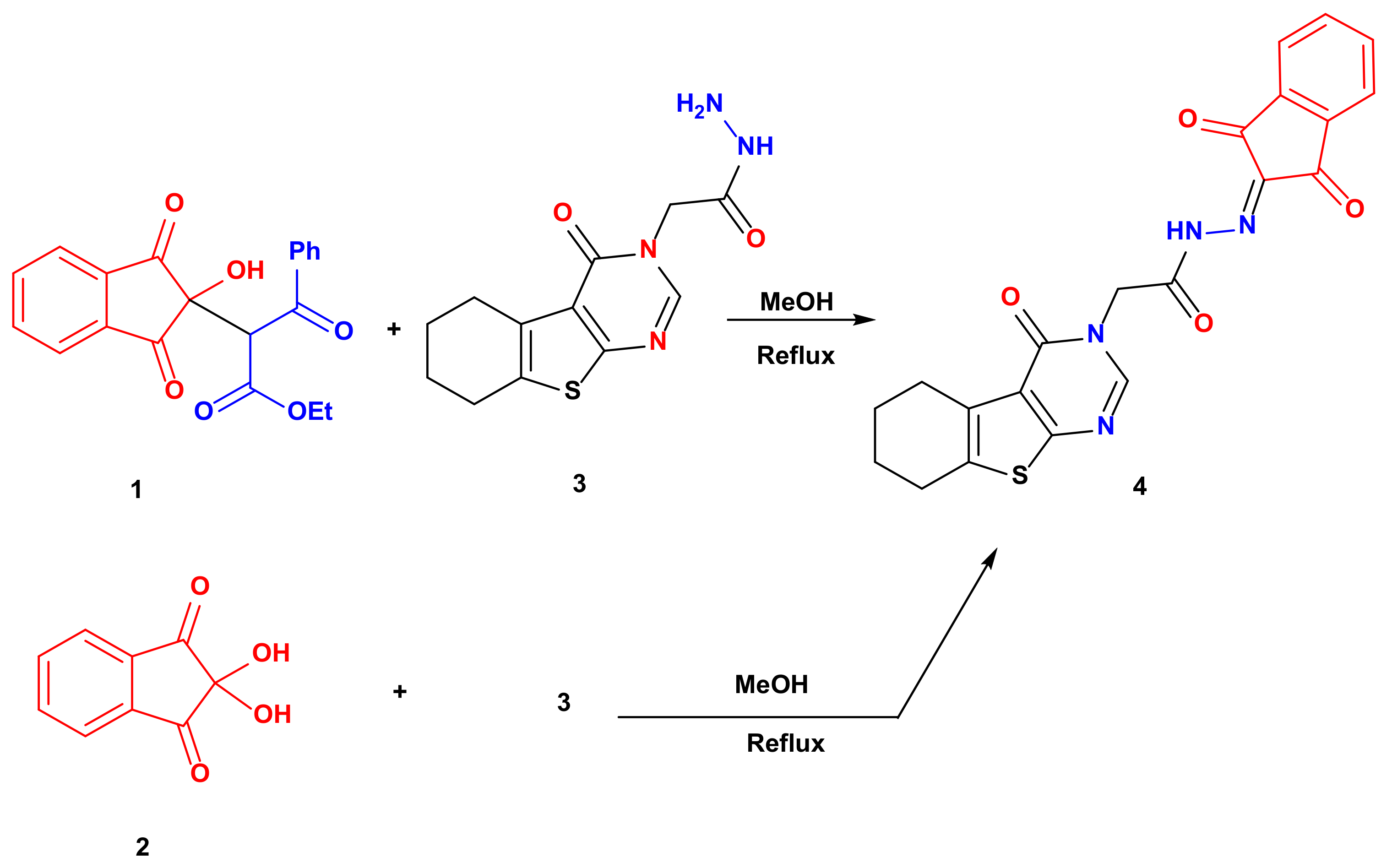

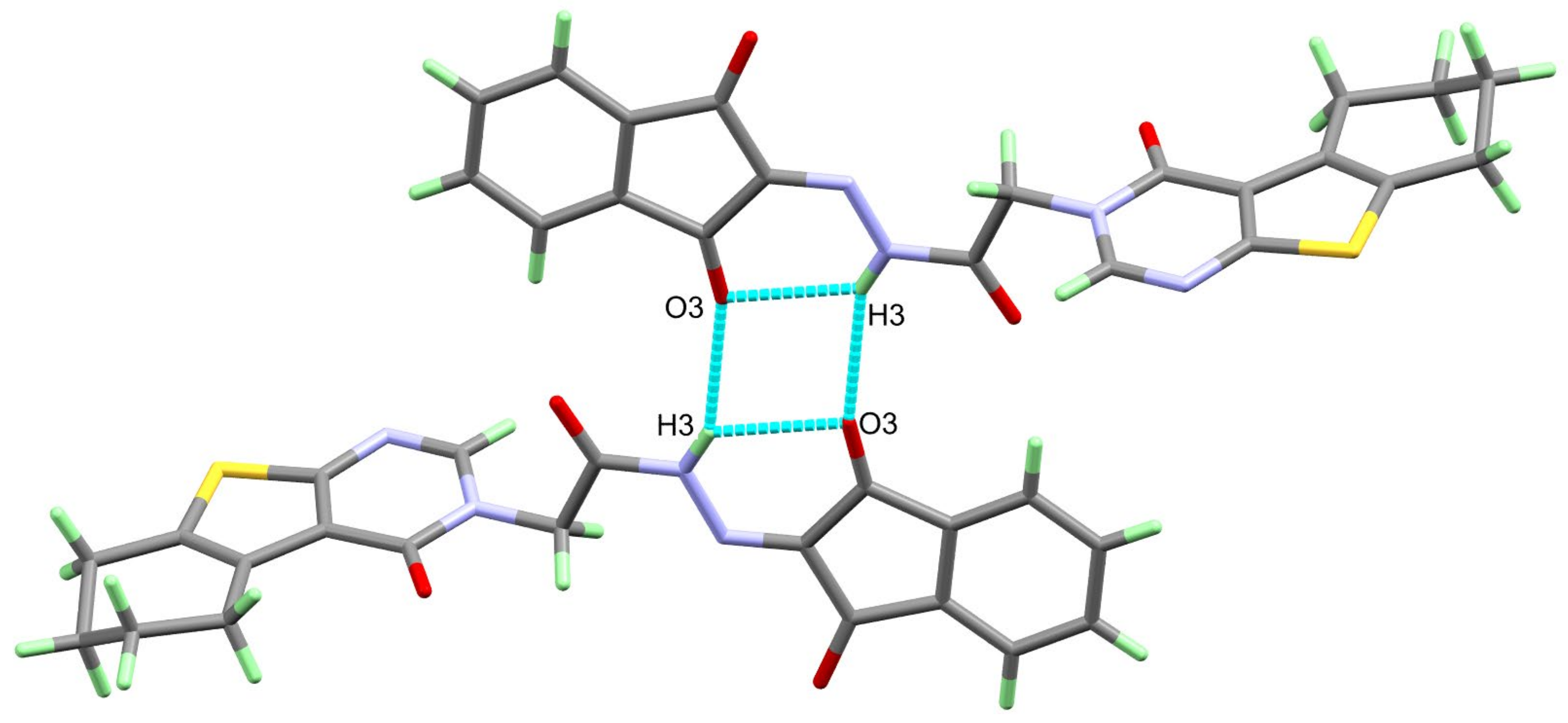
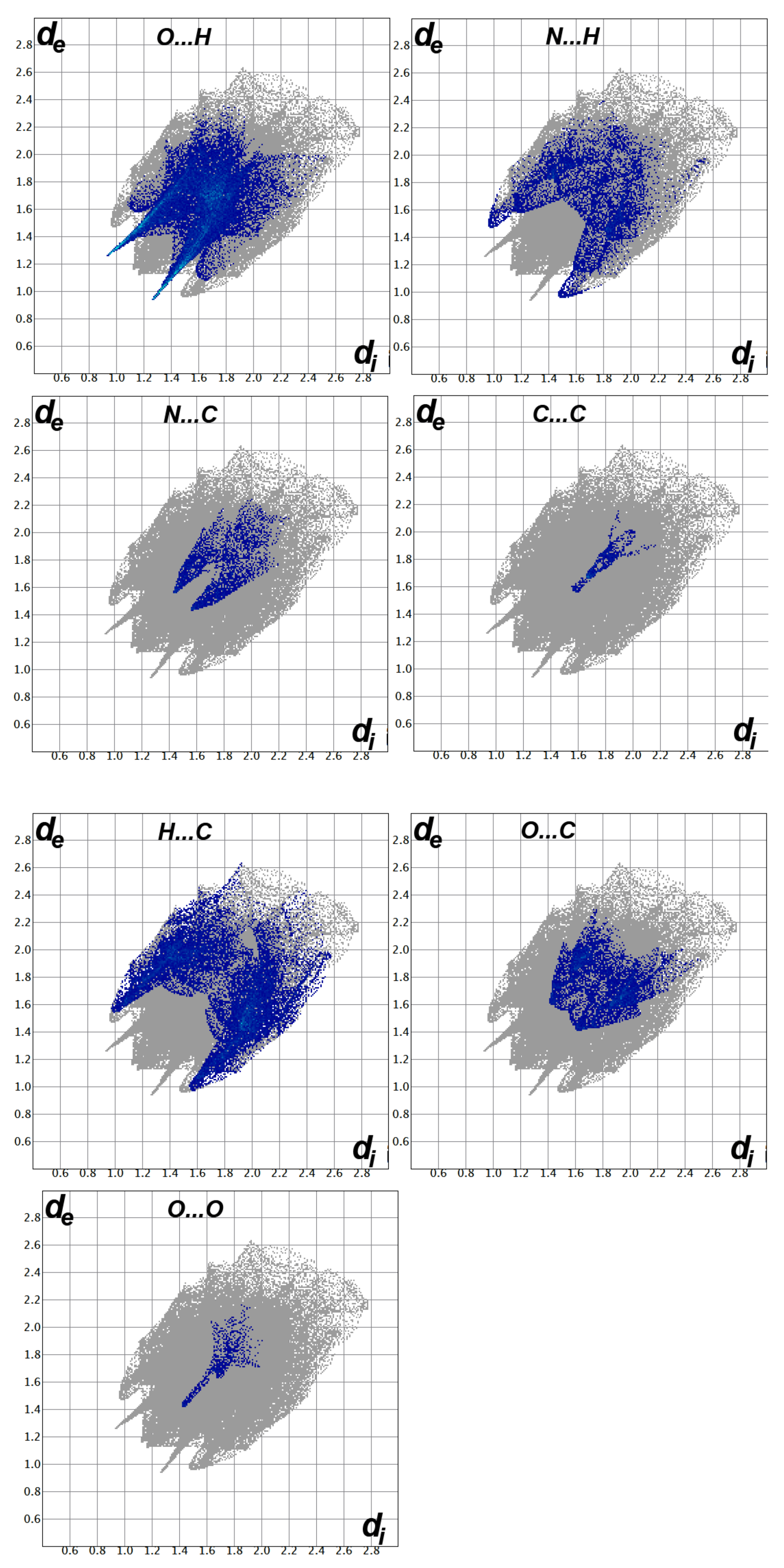

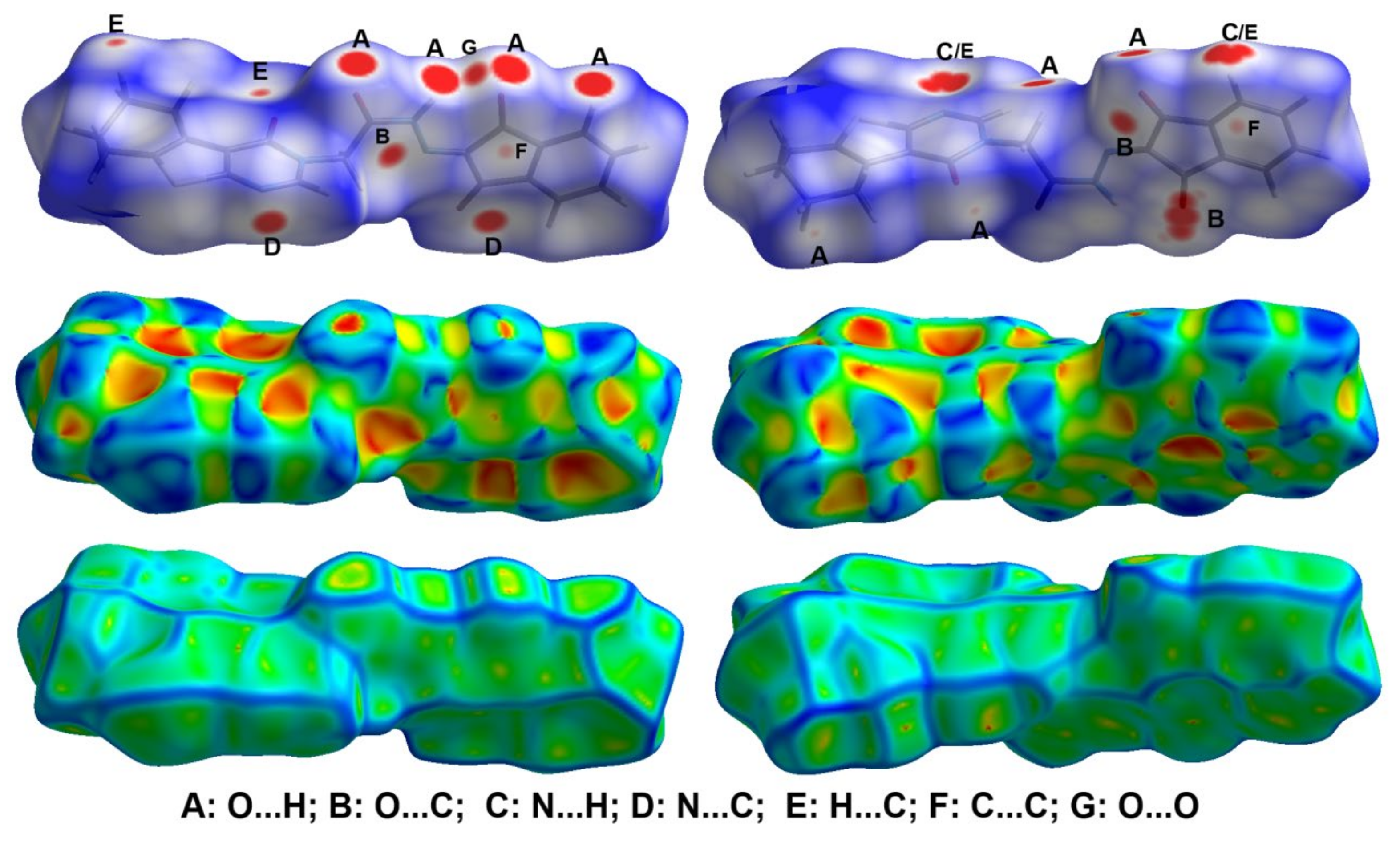
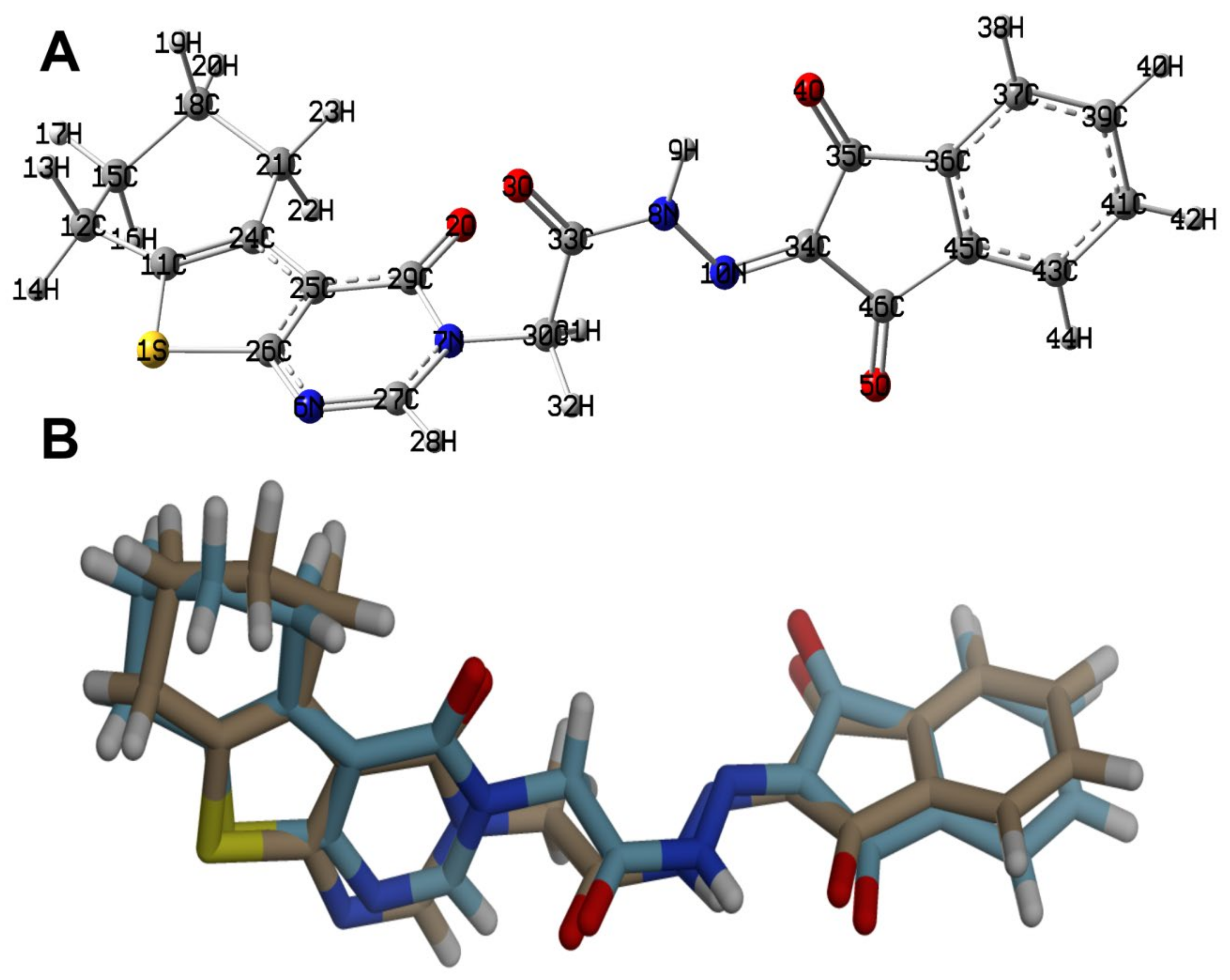



| 4 | |
|---|---|
| CCDC | 2237068 |
| empirical formula | C21H16N4O4S |
| fw | 420.44 |
| temp (K) | 120(2) K |
| λ (Å) | 1.54184 |
| cryst syst | Triclinic |
| space group | P 1 |
| a (Å) | 5.5257 (2) |
| b (Å) | 10.9956 (5) |
| c (Å) | 15.4836 (6) |
| α (Å) | 95.881(3) |
| β (deg) | 100.164(3) |
| γ (Å) | 92.139(3) |
| V (Å3) | 919.65 (7) |
| Z | 2 |
| ρcalc (Mg/m3) | 1.518 |
| μ(Mo Kα) (mm−1) | 1.909 |
| No. reflections | 18314 |
| Unique reflections | 3813 |
| Completeness to θ = 67.684° | 99.9% |
| GOOF (F2) | 1.029 |
| Rint | 0.0688 |
| R1a (I ≥ 2σ) | 0.0479 |
| wR2b (I ≥ 2σ) | 0.1212 |
| Bond | Length/Å | Bond | Length/Å |
| S(1)-C(8) | 1.731 (2) | N(1)-C(8) | 1.362 (3) |
| S(1)-C(1) | 1.741 (2) | N(2)-C(9) | 1.365 (3) |
| O(1)-C(10) | 1.222 (3) | N(2)-C(10) | 1.410 (3) |
| O(2)-C(12) | 1.206 (3) | N(2)-C(11) | 1.460 (3) |
| O(3)-C(14) | 1.216 (3) | N(3)-N(5) | 1.341 (3) |
| O(4)-C(21) | 1.215 (3) | N(3)-C(12) | 1.393 (3) |
| N(1)-C(9) | 1.300 (3) | N(5)-C(13) | 1.292 (3) |
| Bonds | Angle/˚ | Bonds | Angle/˚ |
| C(8)-S(1)-C(1) | 91.18 (11) | C(13)-N(5)-N(3) | 119.38 (19) |
| C(9)-N(1)-C(8) | 114.0 (2) | C(6)-C(1)-C(2) | 125.2 (2) |
| C(9)-N(2)-C(10) | 123.85 (19) | C(6)-C(1)-S(1) | 112.99 (17) |
| C(9)-N(2)-C(11) | 118.31 (19) | C(2)-C(1)-S(1) | 121.78 (18) |
| C(10)-N(2)-C(11) | 117.8 (2) | C(1)-C(2)-C(3) | 109.1 (2) |
| N(5)-N(3)-C(12) | 117.50 (19) |
| D-H…A | D-H | H…A | D…A | D-H…A |
|---|---|---|---|---|
| N(3)-H(3)...O(3) | 0.85 (3) | 2.24 (3) | 2.847 (2) | 128 (3) |
| N(3)-H(3)...O(3) 1 | 0.85 (3) | 2.35 (3) | 3.129 (3) | 154 (3) |
| Contact | Distance | Contact | Distance |
|---|---|---|---|
| O3…C14 | 3.043 | O1…H4B | 2.556 |
| O3…C15 | 3.18 | O4…H11B | 2.303 |
| O4…C12 | 3.028 | O2…H16 | 2.215 |
| N1….C21 | 2.999 | O3…H3 | 2.203 |
| N1…H19 | 2.446 | C14…C19 | 3.337 |
| H19…C8 | 2.621 | O3…O3 | 2.853 |
| H19…C9 | 2.542 | ||
| H4A…C10 | 2.669 |
| NBOi | NBOj | E(2) | NBOi | NBOj | E(2) |
|---|---|---|---|---|---|
| BD(1)C34-C46 | BD×(1)N8-N10 | 5.12 | LP(2)O2 | BD×(1)N7-C29 | 30.89 |
| BD(2)O4-C35 | BD×(2)N10-C34 | 5.69 | LP(2)O2 | BD×(1)C25-C29 | 17.44 |
| BD(2)O 5-C46 | BD×(2)N10-C34 | 5.24 | LP(2)O3 | BD×(1)N 8-C33 | 28.04 |
| BD(2)N 6-C27 | BD×(2)C25-C26 | 19.23 | LP(2)O3 | BD×(1)C30-C33 | 22.7 |
| BD(2)N10-C34 | BD×(2)O4-C35 | 15.23 | LP(2)O4 | BD×(1)C34-C35 | 18.69 |
| BD(2)N10-C34 | BD×(2)O5-C46 | 14.14 | LP(2)O4 | BD×(1)C35-C36 | 20.53 |
| BD(2)C11-C24 | BD×(2)C25-C26 | 14.19 | LP(2)O5 | BD×(1)C34-C46 | 23.52 |
| BD(2)C25-C26 | BD×(2)O2-C29 | 27.20 | LP(2)O5 | BD×(1)C45-C46 | 21.77 |
| BD(2)C25-C26 | BD×(2)N6-C27 | 12.61 | LP(1)N6 | BD×(1)N7-C27 | 14.9 |
| BD(2)C25-C26 | BD×(2)C11-C24 | 16.05 | LP(1)N6 | BD×(1)C25-C26 | 9.67 |
| BD(2)C36-C37 | BD×(2)O 4-C35 | 19.79 | LP(1)N7 | BD×(1)C30-C33 | 7.26 |
| BD(2)C36-C37 | BD×(2)C39-C41 | 19.37 | LP(1)N10 | BD×(1)C34-C35 | 12.11 |
| BD(2)C36-C37 | BD×(2)C43-C45 | 19.79 | LP(2)S1 | BD×(2)C11-C24 | 19.16 |
| BD(2)C39-C41 | BD×(2)C43-C45 | 19.23 | LP(2)S1 | BD×(2)C25-C26 | 22.9 |
| BD(2)C39-C41 | BD×(2)C36-C37 | 20.24 | LP(1)N8 | BD×(2)O3-C33 | 45.77 |
| BD(2)C43-C45 | BD×(2)O 5-C46 | 16.47 | LP(1)N8 | BD×(2)N10-C34 | 42.38 |
| BD(2)C43-C45 | BD×(2)C36-C37 | 19.96 | LP(1)N7 | BD×(2)O2-C29 | 46.69 |
| BD(2)C43-C45 | BD×(2)C39-C41 | 20.07 | LP(1)N7 | BD×(2)N6-C27 | 53.25 |
Disclaimer/Publisher’s Note: The statements, opinions and data contained in all publications are solely those of the individual author(s) and contributor(s) and not of MDPI and/or the editor(s). MDPI and/or the editor(s) disclaim responsibility for any injury to people or property resulting from any ideas, methods, instructions or products referred to in the content. |
© 2023 by the authors. Licensee MDPI, Basel, Switzerland. This article is an open access article distributed under the terms and conditions of the Creative Commons Attribution (CC BY) license (https://creativecommons.org/licenses/by/4.0/).
Share and Cite
Altowyan, M.S.; Haukka, M.; Soliman, S.M.; Barakat, A.; Boraei, A.T.A.; Sopaih, M. Synthesis of a Novel Hydrazone of Thieno[2,3-d]pyrimidine Clubbed with Ninhydrin: X-ray Crystal Structure and Computational Investigations. Crystals 2023, 13, 384. https://doi.org/10.3390/cryst13030384
Altowyan MS, Haukka M, Soliman SM, Barakat A, Boraei ATA, Sopaih M. Synthesis of a Novel Hydrazone of Thieno[2,3-d]pyrimidine Clubbed with Ninhydrin: X-ray Crystal Structure and Computational Investigations. Crystals. 2023; 13(3):384. https://doi.org/10.3390/cryst13030384
Chicago/Turabian StyleAltowyan, Mezna Saleh, Matti Haukka, Saied M. Soliman, Assem Barakat, Ahmed T. A. Boraei, and Manar Sopaih. 2023. "Synthesis of a Novel Hydrazone of Thieno[2,3-d]pyrimidine Clubbed with Ninhydrin: X-ray Crystal Structure and Computational Investigations" Crystals 13, no. 3: 384. https://doi.org/10.3390/cryst13030384
APA StyleAltowyan, M. S., Haukka, M., Soliman, S. M., Barakat, A., Boraei, A. T. A., & Sopaih, M. (2023). Synthesis of a Novel Hydrazone of Thieno[2,3-d]pyrimidine Clubbed with Ninhydrin: X-ray Crystal Structure and Computational Investigations. Crystals, 13(3), 384. https://doi.org/10.3390/cryst13030384










